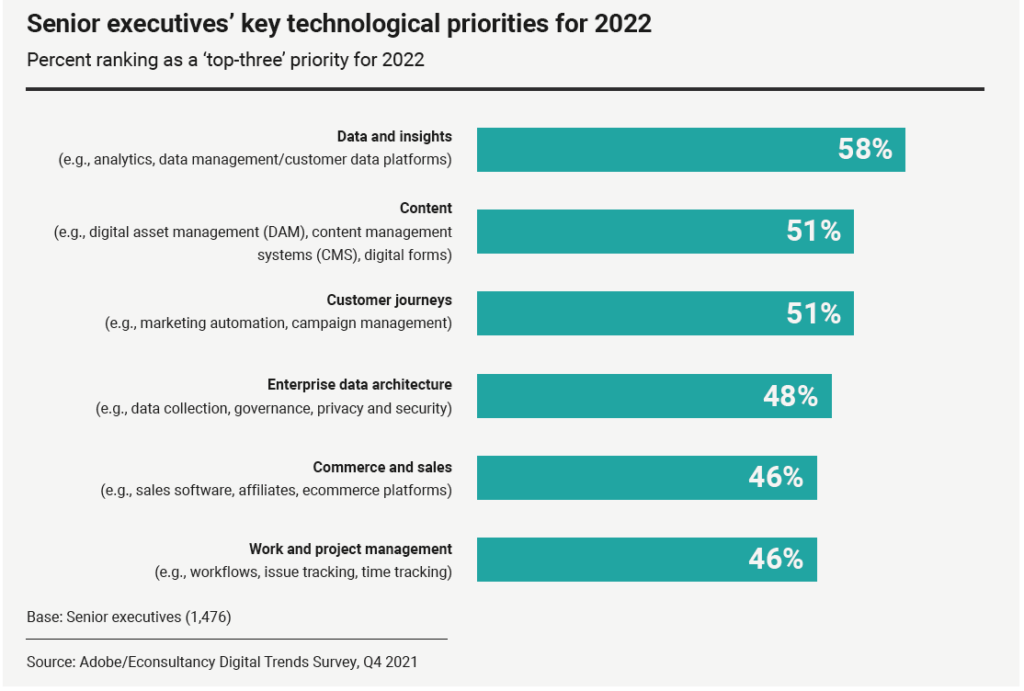How to unify customer data for data-driven marketing
Data-driven marketing has been a buzzword for digital marketers for a while now; it has long been emphasized as the tactic behind marketing success. In fact, the majority of marketers in a recent survey cited data-driven marketing that focuses on an individual as “the single most exciting opportunity” emerging in the industry.

What is data-driven marketing?
Data-driven marketing is an approach to marketing that focuses on strategies built on insights pulled from big data. This data is a collection of customer information, interactions, engagements, and purchases that can be used to form predictions about future behaviors.
Ultimately, the goal of data-driven marketing is to enhance and personalize the customer experience to drive growth, conversions, and customer retention.
Data-driven marketing is no longer a theoretical and innovative approach, it should be a fundamental part of your marketing strategy.
Brands around the world have accelerated their digital transformation as a result of the global pandemic that hit back in 2020 and has forced marketers to re-evaluate their digital engagement strategy. Similarly, there has been a significant shift in customer behavior as they opt more and more to interact with brands through digital experiences.
But, where many brands have experienced unusual and rapid growth in the number of customers discovering them online, there have also been unusual buying behaviors and increasingly high churn. In response, marketers are doubling down on their efforts to improve the effectiveness and efficiency of their data.
With technology and platforms like Dotdigital so fundamental to modern marketing, it’s essential brands focus on how to get the best value possible from the big data they have available. Can it unify all your sources of data? How quickly can you pull insights from your data?
Why is unified data important?
Today, most companies are ‘data-rich’. That is, they have vast amounts of data on their audience. The trouble lies in a company’s ability to tap into that data.
What is data unification?
Data unification is the process of collecting raw data from multiple sources, systems, and formats and standardizing it so it can be treated as a single source of unified and accurate data.
In a study by Econsultancy, only 23% of brands believed their organization was ‘very strong’ in terms of being able to pull actionable insights from big data. When you consider the numerous benefits of having a single source of data truth, it’s clear to see why so many businesses are stating that improving their data and insights is a top priority for 2022.

Benefits include but are not limited to:
- More accurate analytics and enhanced business intelligence
- Higher data quality
- Reduced overall costs
- Higher ROI
- Faster time-to-market
- Optimized sales and marketing
- Faster and more accurate decision-making
- More visibility of cross-selling and up-selling opportunities
- Improved employee productivity
- Smarter product management
- Improved operational risk management
- Reduced supplier onboarding costs
- Streamlined supply chain management
- Enhanced compliance with privacy legislation
- Superior customer experience (CX)
Organizations need to ensure that they have the ability to unite multiple systems, transform them into clean, reliable, contextual, and timely data and make it easily accessible to teams across the business.
Data unification is not a 'nice-to-have'. It’s essential for efficient data-driven marketing that drives profits, growth, and customer retention.
What to consider when streamlining and unifying your martech stack
For true organization-wide success, you need to go further than unifying your internal systems. Being able to understand and interpret online and offline customer behavior will empower your marketing team, offering new ways to automate and optimize marketing spend and feed the sales funnel.
Unfortunately, the constant evolution of marketing solutions and changing expectations of customers means that martech stacks often become a mishmash of systems.
The biggest perceived barrier preventing marketers from creating the ultimate customer experience is ‘poor integration between tech systems’. But, when looking deeper into the problem, it is more likely that the true problem lies with marketers either using multiple technologies or vendors, without a unifying platform.
Unifying your data sources can reduce costs by 25-35% and increase speed to market by 30%. Bringing together your marketing stack, pruning legacy systems, and modernizing applications will enhance customer experiences, drive customer retention, reduce costs, streamline marketing and sales workflows, minimize code maintenance and end data siloes. Now, let’s look at what you need to consider when unifying your stack.
Single customer view
90% of people now travel across devices and touchpoints to complete a single task, generating tons of data along the way. Legacy and outdated systems like CRMs can no longer process, sync, and interpret this data in real-time. A single view of the customer pulls all this information together.
What is single customer view?
Single customer view (SCV) is a single location for every individual you interact with. It provides you with an overview of all the data you’ve collected throughout their relationship with your brand.
Your SCV should sit at the heart of your business. Customer-centricity is essential for survival in this modern, digital-first world we live in. An SCV gives all departments and teams access to valuable information to improve performance. Executives can use it to make key business decisions supported by accurate and insightful data. Marketers can use it to deliver more personalized and profitable campaigns. Customer support agents can use SCV insights to resolve issues faster. The potential for growth and success is limitless.
Overall, the improvements you can make to the customer experience will improve retention, increase customer lifetime value (CLV), and directly impact your bottom line.
2. Cross-account reporting
As your business grows and develops, you need a martech stack that grows with you. Whether you have multiple storefronts, operate in different regions each with individual currencies, or manage separate brands under one umbrella group, you need to be able to pull information on your sales, campaigns, and marketing activity across all facets of your business.
Getting a bird’s-eye view of your performance through cross-account reporting across all regions and business divisions gives decision-makers in your company a clear view of what’s happening. This helps all teams identify risks, weaknesses, and missed opportunities where performance can be optimized. Similarly, campaigns and activities that yield high rewards can be double-downed on, invested in, and used to drive business profitability.
3. Open integrations
When streamlining your marketing systems, you need to know your data unification platform plays nicely with others. That means, it is open to integrating with the vast number of other systems out there.
With so much data at your fingertips, you need to have confidence that you can tap into this and gather insights with speed. At the same time, you don’t want to find yourself limited by your platform’s ability to integrate with new tech as you grow. You need a platform that can do it all.
Open APIs and self-serve functionality enable you to continue to grow your martech stack while keeping your systems streamlined.
Data unification = data action + data collection
Data unification is not a ‘nice-to-have’. It’s essential for efficient data-driven marketing that drives profits, growth, and customer retention.
We’re in a new era of customer expectations. Changes to data regulations and increasing privacy consciousness means customers are more engaged with brands’ data collection methods than ever before. At a time when trust in brands is at an all-time low, customers want to know the value they will get from sharing their data. How will marketers put it to use to improve their experience?
It is your brand’s responsibility as data stewards to use data respectfully and create valuable customer experiences. Marketers must think about what actions they want to take and what data they need before they begin collecting data.
Unifying your data into a single source makes this data and insight accessible, not just to the marketing team, but to the whole business. Decisions can be made across the business with your customers in mind. True customer-centricity is only possible if you connect all your data.
